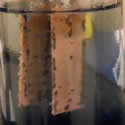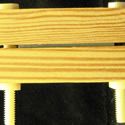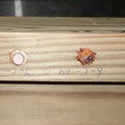Laboratory Corrosion Aspects Tests
Wood protection methodology is often focused on the "core" needs of protecting wood products in service from biodegradation and physical degradation, such as caused by weathering. An important other need is the impact of wood protection agents on corrosion issues, such as when solutions impact treatment equipment, or the impact of treated wood products on corrosion of fasteners in service. In reality, corrosion issues are a form of chemical degradation.
A number of methods are used for studies in both areas, that is for solution corrosion impacts and for fastener impacts in service. Some methods are quite complex, such as the kinetic corrosion methods for solution studies, while others are simple but effective, such as beaker tests with metal coupons partially immersed in the wood protection treatment solution. All have there place, but must be used with caution and appropriate choice of controls. The AWPA test for solution corrosion is found in AWPA Standard E17.
In the case of fastener corrosion, more complex situations are often encountered making testing and comparisons challenging. Wood product treatments that alter the moisture content of wood in service can have little impact on apparent corrosivity in laboratory while having major impacts in service. Similarly, the common methodologies of single metal testing in laboratory tests can be a less than optimal predictor of perfomance when mixed metals are encountered in service. Also, in situations where electrical charge can be developed in a usage in service, wood degradation similar in appearance to decay can occur from hydroxide release caused by the fastener-wood interactions. A standard method for testing corrosion in treated wood can be found in AWPA Standard E12.
In summary, corrosion testing using a variety of methods is useful, but interpretation of results for any given specific situation must be approached with caution.
Images
References


